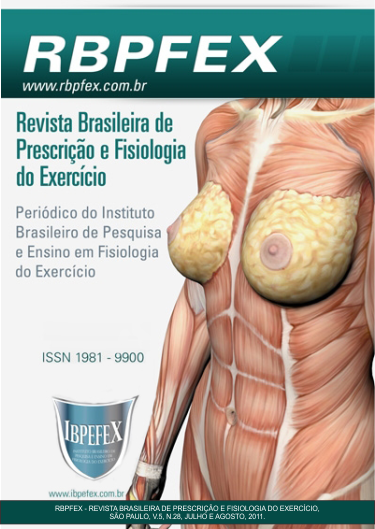Electromyographic analysis in the activation of abdominal muscles in traditional and nontraditional abdominal exercises
Abstract
Activities aiming the strengthening of the abdominal muscles are widely used by practitioners of exercises, whether they are athletes, those aiming health, or aesthetics. Understanding how these exercises act at the abdominal muscles is extremely important for health professionals dealing with resistance training. There are many accessories and devices available that are believed to be more effective in activating the abdominal muscles, promising to reduce the stress on other muscles, but some doubts still remain regarding the specific effects of exercise on the development of the muscles and muscle activation. Surface electromyography (EMG) has been the most frequently used tool for studying muscle activation during exercise. We considered ten relevant studies in this review, published between 2003 and 2011. Devices such as the Ab slide, Fit ball, Torso Track, Perfect Abs, Power Wheel are very efficient in the recruitment of the abdominal muscles when compared to the crunch or sit-ups, but should be used cautiously by beginners with weak abdominal and lumbar muscles, and column pathologies. It is suggested that further studies with a greater control of variables should be realized to obtain more consistent and reliable data that can contribute to a better understanding of the subject.
References
-Baldissera,V.; e colaboradores. Comparação dos exercícios abdominais convencionais através da eletromiografia no domínio do tempo. Anais 25th International Symposium on Biomechanics in Sports. Ouro Preto, p. 660-662. 2007.
-Bird, M.; e colaboradores. Electromyographic comparison of the ab-slide and crunch exercises. Journal of strength and conditioning research. Vol. 20, Núm. 2, 2006.
-Ekstrom, R.A.; e colaboradores. Electromyographic analysis of core trunk, hip, and thigh muscles during 9 rehabilitation exercises. Journal of orthopaedic & sports physical theraphy. Vol. 37, Núm. 12, 2007.
-Escamilla, R.F.; e colaboradores. Electromyographic analysis of traditional and nontraditional abdominal exercises: implications for rehabilitation and training. Physical Therapy. Vol. 86, Núm. 5, 2006.
-Escamilla, R.F.; e colaboradores. An electromyographic analysis of commercial and commom abdominal exercises: Implications for rehabilitation and training. Journal of orthopaedic & sports physical theraphy. Vol. 36, Núm. 2, 2006.
-Escamilla, R.F.; e colaboradores. Core muscle activation during swiss ball and tradicional abdominal exercises. Journal of orthopaedic & sports physical therapy. Vol. 40, Núm. 5, 2010.
-Hildenbrand, K.; e colaboradores. Abdominal muscle activity while performing trunk-flexion exercises using the ab roller, abslide, fitball, and conventionally performed trunk curls.Journal of Athletic Training. Vol. 39, Núm. 1, p. 37-43, 2004.
-Lawson, D.; e coloaboradres. Comparison of a standard abdominal curl and six different exercises using a portable abdominal machine. The Journal of Applied Research. Vol. 11, Núm. 1, 2011.
-Lizardo, F.B.; e colaboradores. Análise eletromiográfica da atividade elétrica dos músculos reto do abdome e reto femoral em exercícios abdominais com e sem bola de ginástica. Coleção Pesquisa em Educação Física, Vol. 6, p. 87-94, 2007.
-Lizardo, F.B.; e colaboradores. Análise Eletromiográfica Comparativa Dos Músculos Reto Do Abdome E Reto FemoralEm Exercícios Abdominais Com E Sem A Utilização Do Aparelho Ab Swing. Biosci. J, Vol. 25, Núm. 3, p. 92-103, 2009.
-Liberali, R. Metodologia Científica Prática: um saber-fazer competente da saúde à educação. 2ª edição revisada e ampliada, Florianópolis: Postmix, 2011.
-Manso, J.M.G.; e colaboradores. Treinamento dos músculos abdominaise lombares. Phorte Editora, p. 35, 37, 57, São Paulo, 2008.
-Monfort-Panego, M.; e colaboradores. Electromyographic studies in abdominal exercises: a literature synthesis. Journal of manipulative and physiological therapeutics. Vol. 32, Núm. 3, 2009.
-Marques, B.M. Comparação da Eficácia de Dois Exercícios de Treino Abdominal Através da Analise Electromiográfica. Coimbra, 2008/2009.
-Norris, C.M. Abdominal muscle training in sport. Br J Sp Med, Vol. 21, Núm. 1, 1993.
-Piering, A.W.; e colaboradores. Electromyographic analysis of four popular abdominal exercises. Journal of athletic training. Vol. 28, Núm. 2, 1993.
-Ralston, S.H.; e colaboradores. Prevalence of vertebral compression fractures due to osteoporosis in ankylosing spondylitis. BMJ, Vol. 300, 1990.
-Ricci, B.; e colaboradores. Biomechanics of sit-up exercises. Med Sci Sports Exerc. Vol. 13, Núm. 1, 1981.
-Rutkoska-Kucharska, A.; e colaboradores. Symmetry of muscle activity during abdominal exercises. Acta of bioengineering and biomechanics. Vol. 11, Núm. 1, 2009.
-Sternlicht, E.; e colaborodres. Electromyographic Analysis of Abdominal Muscle Activity Using Portable Abdominal Exercise Devices and a Traditional Crunch. Journal of strength and conditioning research, Vol. 17, Núm. 3, 463-468, 2003.
-Sternlicht, E.; e colaboradores. Electromyographic comparison of a stability ball crunch with a traditional crunch. Journal of strnght and conditioning research. Vol. 21, Núm. 2, 2007.
-Vaz, M.A.; e colaboradores. Análise de exercícios abdominais: um estudo biomecânico e eletromiográfico. Revista Brasileira de Ciência e Movimento. Vol. 5, Núm. 4, 1991.
Authors who publish in this journal agree to the following terms:
- Authors retain the copyright and grant the journal the right of first publication, with work simultaneously licensed under the Creative Commons Attribution License BY-NC which allows the sharing of the work with acknowledgment of the authorship of the work and initial publication in this journal.
- Authors are authorized to enter into additional contracts separately for non-exclusive distribution of the version of the work published in this journal (eg, publishing in institutional repository or book chapter), with acknowledgment of authorship and initial publication in this journal.
- Authors are allowed and encouraged to post and distribute their work online (eg, in institutional repositories or on their personal page) at any point before or during the editorial process, as this can bring about productive change as well as increase impact and impact. citation of published work (See The Effect of Free Access).






